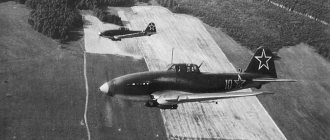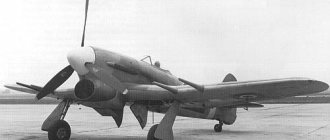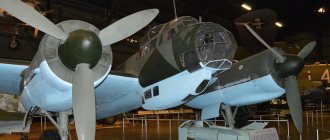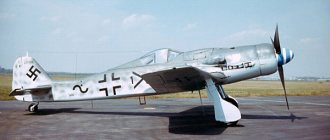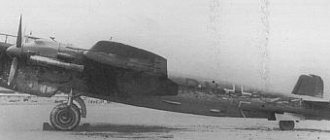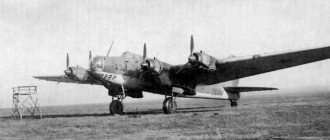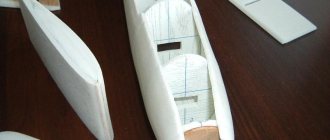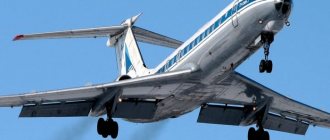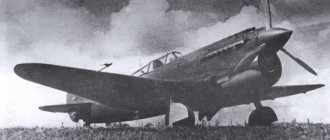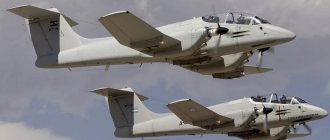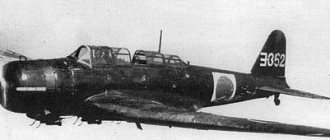Medium bomber
Dornier
The Do-17M/P medium bomber and reconnaissance aircraft, equipped with Bramo-323 radial engines, was created on the basis of the Do-17E/F. Following this aircraft, the Do-17S/U reconnaissance aircraft was released, on which a water-cooled engine was again installed, and the front part of the hull was shortened and a new glazed “bee's eye” cockpit was installed. After 18 pre-production Do-17S/U, an order was issued for the construction of the main Do-17Z model with air-cooled engines; a total of 522 cars were produced. Three additional modifications are the Do-17Z-1 with a 500 kg bomb load, the Do-17Z-2 with a more powerful engine and increased bomb load, and the Do-17Z-3 reconnaissance bomber. Other options included the Do-17Z dual-control trainer, the Do-17Z-5 naval reconnaissance aircraft, the Do-17Z-6 long-range night fighter (with a Ju-88C-2 nose), and another night fighter, the Do-17Z-10. with a modified nasal compartment.
Do 17Z-6.
From time to time, the Luftwaffe High Command showed considerable reluctance to face the unpleasant. The most striking example of this disgust is his attitude towards German night air defense in the period immediately preceding the Second World War and in the early years of the conflict itself. This reluctance to consider the possibility that the Luftwaffe might require significant night fighter aircraft came from the commander himself, Hermann Goering. He seriously criticized any possibility of moving to a defensive mindset, and German air power was seen as a purely offensive force. This complacency of the Luftwaffe command was seriously undermined on the night of 15/16 May 1940, when a force of 99 Wellingtons, Whitleys and Hampdens attacked industrial and transport targets in the Ruhr. The fog rendered the searchlights useless and, as a result, the anti-aircraft batteries were blinded. Goering personally ordered Colonel I. Kammhuber to create night fighter forces, although they were not considered defensive.
Named "Kautz" (Owl), the initial conversion was designated Do 17Z-6. It differed from the original aircraft by three 7.92 mm MG17 machine guns and one MG FF (Oerlikon) cannon, housed in a new nose cone, which had an 11 mm armored partition. The crew consisted of a pilot, radio operator-navigator and flight engineer. The latter was also responsible for changing the drum-type magazines of the gun, the lock of which was located in the crew compartment. The forward of the two bomb bays was used to install an additional 900 liter fuel tank. The rear compartment was retained to accommodate two 250 kg SD250 bombs or ten 50 kg SD50s. Only one Do 17Z-6 was built. The placement of the bow weapons turned out to be not entirely satisfactory. The remaining nine Do 17Z-3s, converted on the assembly line into night fighters, had completely different weapons.
Do 17Z-10.
Designated Do 17Z-10 "Kautz II", the improved variant had a forward-facing fixed armament of four 7.92 mm MG 17 machine guns in the upper section of the nose and a pair of MGFF cannons below them. Boxes with ammunition for machine guns were placed like magazines for submachine guns, and drums with shells for guns were replaced manually by a flight engineer. An infrared sensor of the so-called “Spanner-Anlage” type was installed in the windshield. It reacted to hot exhaust gases spreading behind any aircraft. Their presence was recorded on a small screen known as a "Q-tube". Since the sensor could not distinguish friendly from enemy aircraft, the responsibility for deciding whether a detected aircraft was a "legitimate" target rested with the pilot.
The 3rd Squadron of the 1st Night Fighter Group (NJG1) received the Kautz II and was transferred to the 2nd Group (NJG 2), receiving the designation 4/NJG 1. It began operating from Dylan as a separate unit under the direction of the Special Command "Schiphol."
Do 17Z-10 4/NJG1 had some success and, together with I/NJG2, formed at the same time on the Ju 88C-2, they created the tactic of infiltrating into the “circle” of British bombers during landing.
Although this tactic resulted in the downing of several aircraft, the biggest result was a secondary one: many aircraft were severely damaged in hasty landings due to the pilots' desire to land as quickly as possible. Production of the Do 17 was soon discontinued: the Kautz II fighters were actually the last Do 17Z-3 on the assembly line. Characteristics
| Crew | 4-5 people |
| Dimensions. | |
| Wingspan, m | 18 |
| Aircraft length, m | 15,8 |
| Aircraft height, m | 4,6 |
| Engine. | |
| 2 x 9-cylinder single-row radial Bramo-323P (BMW) | 1000 hp |
| Weights and loads, kg: | |
| Empty plane | 5200 |
| Maximum takeoff | 8590 |
| Flight data. | |
| Maximum speed, km/h | 410 |
| Practical ceiling, m | 8200 |
| Flight range, km | 1500 |
| Armament | |
| One or two 7.92 mm machine guns in each of the windows - in the nose, in the cabin in front and behind and under the cabin, bombs up to | 1000kg |
Light bomber
Dornier
Designed as a high-speed mail plane and first flown in 1934, the Do-17 soon “changed its specialization.” Three single-fin aircraft of this model were followed by 12 prototypes of a new high-speed bomber with a twin-fin tail. This aircraft entered service in early 1937 and soon earned the nickname "flying pencil" for its highly elongated fuselage.
The first military modification had two designations: Do-17E-1 - high-speed bomber and Do-17F-1 - long-range photo reconnaissance aircraft; on the latter, instead of a bomb load, additional fuel tanks and two cameras were installed. These two models were distinguished by high speed and were considered fully consistent with the standards of that time, but quickly became outdated.
Do 17E-3 in the USSR before the war.
At least twice, the planes fell into the hands of Soviet specialists in quite good condition. On March 20, 1941, a Do 17E-1 landed at the Velsk airfield in Western Belarus, and the next day a Do 17E-3 landed nearby in the town of Tsekhanovets. In both cases, the crews allegedly lost their bearings in difficult weather conditions. The planes belonged, respectively, to the Warsaw and Torun aviation schools and were studied in detail by Air Force Research Institute engineers who promptly arrived on the scene. Compared to the Do 215 purchased by the Soviet Union, these machines differed for the worse. Our experts noted the cramped cabin, unsatisfactory visibility, small angles of fire for machine guns, and low-power BMW VI engines. The inspection report signed by 1st rank military engineers Kulikov and Avakimyan, as well as 2nd rank military engineer Gulnik stated: “Built in 1936-1937. Do 17E aircraft are obsolete, the Germans are removing them from combat aviation and are transferring them to schools for use for educational purposes... The aircraft are of no interest to us.”
The captured planes were returned to Germany, at least one of them;
the above mentioned Do 17E-3 No. 3003 is known to have been used by the Germans as glider tugs during the war with the Soviet Union until 1943. Characteristics
| Crew | 3-4 people |
| Dimensions | |
| Wingspan, m | 18 |
| Aircraft length, m | 16,25 |
| Aircraft height, m | 4,32 |
| Power point | |
| 2 x 12-cylinder V-shaped BMW VI-7.3 | 750 hp |
| Weights and loads, kg: | |
| Empty plane | 4500 |
| Maximum takeoff | 7040 |
| Flight data | |
| Maximum speed, km/h | 355 |
| Practical ceiling, m | 5100 |
| Flight range with maximum bomb load, km | 500 |
| Armament | |
| 7.92 mm machine gun on the starboard side, space for a 7.92 mm machine gun in the lower canopy, 7.92 mm machine gun on a turret at the rear of the cockpit, 7.92 mm machine gun under the fuselage, bombs in the bomb bay | 750kg |
Modifications of Do-17
- Do 17E-1 is the first serial modification of the bomber produced since 1937. The bomb load was only 500 kg; defensive armament consisted of one 7.92 mm machine gun mounted openly in the rear of the cockpit. The aircraft was tested in combat operations in Spain.
- Do 17F-I is a three-seat reconnaissance aircraft produced in parallel with the “E” modification. RB 50/18 or RB 50/30 aerial cameras were installed in the bomb bay and LC 50F illumination bombs were suspended.
- Do 17K is an export version of the Do 17, developed for Yugoslavia. It had French engines Gnome-Rom 14N1/2. There were variants of the Do 17Kv-1 bomber and Do 17Ka-2 and Do 17Ka-3 reconnaissance aircraft.
- Do 17M is a further development of the “E” modification with an electric drive for retracting the landing gear, a closed upper rear firing point and two Bramo 322A-1 engines. The bomb load was increased to 1000 kg.
- Do 17P is a reconnaissance aircraft, similar in design to the M modification. Do 17 aircraft of the “M” and “P” modifications were built under license in Yugoslavia. The total number of vehicles built was approximately 70 units.
- Do 17R is an experimental aircraft for testing engines and special equipment.
- The Do I7S is an experimental high-speed reconnaissance aircraft with DB 600G engines and a new crew cabin with a large glass area.
- Do 17U is a modification of the air command post with a crew of five people, developed on the basis of the “Z” modification.
- Do 17Z - developed on the basis of the experience of the war in Spain and produced since 1939, the main serial modification. A total of 509 vehicles of this modification were produced, the following options were available:
- Do 17Z-0 is an experimental aircraft of the “Z” modification. which was a development of the “S” modification with two Bramo 323A-1 engines with a power of 900 hp. With. and with defensive weapons of three 7.92 mm MG 15 machine guns.
- Do 17Z-1 - production version with an additional 7.92 mm machine gun in the forward fuselage. The bomb load was clearly insufficient - 500 kg.
- Do 17Z-2 - version with 1000-hp Bramo 323R engines, bomb load increased to 1000 kg.
- Do 17Z-3 - photo reconnaissance variant, 22 aircraft produced.
- The Do 17Z-4 is a dual-control trainer aircraft.
- The Do 17Z-5 was an experimental aircraft used to develop a means of rescuing bombers shot down over the sea. Had inflatable rubber bags in the bomb bay and in the engine nacelles.
- The Do 17Z-6 and Z-10 are night fighter-interceptors developed in 1940 to combat British bombers. They had powerful machine-gun and cannon weapons and infrared aircraft detection equipment.
In the mid-1930s, rumors began to leak into the French and British aviation ministries about a very fast Schulterdecker-kampfflugzeug - a top-wing bomber, supposedly faster than existing fighters. The existence of such an aircraft was confirmed by the demonstration in Bückeberg in October 1935 of one of the experimental aircraft. But only in July 1937, when the Do 17V8, participating in an international military aircraft competition in Zurich, won the Circle of the Alps race, beating all fighters, it became clear that such an aircraft had actually been created. The bomber had such a thin profile that it was immediately dubbed the “flying pencil”. His demonstration in Zurich had a significant international resonance.
But what was not known in Zurich was the fact of the generally accidental transformation of the Do 17 into a bomber. It was not yet known that the prototype aircraft demonstrated in Zurich was specially “polished” and had a much more powerful propulsion system than on the production models supplied to the Luftwaffe. The Zurich aircraft was a purely demonstration model with a maximum speed 90 km/h higher than the production bomber.
The Do 17 was created when in Germany the theory of air warfare assigned a secondary role to fighters, giving primacy to high-speed bombers capable of evading interception. Although this theory had yet to be proven, it was revived with the advent of the Do 17, which signaled the German inclination towards relatively small, powerful, high-wing load, but multi-role aircraft of this type. The Germans adhered to this concept throughout the war. The most remarkable feature of the history of the Do 17 was that, unlike the He 111, which was designed from the very beginning as a bomber, the Dornier aircraft was developed exclusively as a commercial aircraft!
For use in the European "express service", Lufthansa ordered a high-speed mail aircraft capable of carrying mail and six passengers. To meet these requirements, Dornier designed an aircraft using the latest advances in aerodynamics and the most powerful German engines - the BMW VI with a take-off power of 660 hp. With. The most characteristic feature of the project was the extremely elongated fuselage profile, topped by an equally long nose. The Do 17 had a “very” thin profile, but its center section was nevertheless very wide. The forward section of the fuselage transitioned from an oval shape to an inverted triangle twice as wide at the top in the central section of the fuselage. Then the fuselage again switched to an oval cross-section.
The fuselage was assembled from frames connected by stringer channels and was covered with light alloy sheets. The wing had a two-spar structure with partly metal and partly fabric covering. The spars were an asymmetrical profile made of thin duralumin. The main ribs were assembled from duralumin channels, and the additional ones had a tubular frame. Fabric covering was used between the spars on the lower surface of the wing. Slotted flaps ran from the ailerons to the fuselage. All the fuel was located between the center section spars near the fuselage. The main landing gear retracted back into the engine nacelles. The rear wheel was also retractable.
The first experimental Do 17 VI was completed and flew in the fall of 1934, and before the end of the year the Do 17 V2 and V3 joined the test program. All three aircraft were transferred to Lufthansa for testing in 1935. Although the aircraft was fully suitable for Lufthansa in terms of flight characteristics, the latter quickly concluded that the Do 17 was not suitable for practical use due to insufficient passenger and fat capacity. The narrow fuselage contained only two very cramped cabins. The first for two people was located immediately behind the double cockpit, and the second for four people was located behind the wing. Unfortunately, passengers had to perform amazing acrobatics to get into these tiny cubicles, and special “dexterity” was required to take their place. Lufthansa reasoned that such a “service” would immediately affect the company’s commercial reputation. As a result, three prototype aircraft were returned to Dornier. It is likely that this would have been the end of the Do 17’s career if not for a chance visit to Leventhal by a former employee of the company, Flight Captain Unticht.
Unticht, who after leaving Dornier joined Lufthansa and served there as a pilot and at the same time as a liaison officer between the airline and the Ministry of Aviation, decided to fly one of the experimental Do 17s. Good impressions of the handling and high flight characteristics of the aircraft allowed Unticht to propose, after installing an additional fin to ensure greater stability, to use the aircraft as a bomber * Although Dornier personnel were skeptical about this idea, the RLM Technical Department considered Unticht's proposal acceptable. After preliminary studies of the aircraft by an RLM pilot, the company received an offer to produce a fourth prototype aircraft with minimal modifications to the combat aircraft. Thus, at the end of the summer of 1935, the Do 17 V4 appeared, which differed from its predecessors externally only in the sealing of the windows and the installation of spaced tail surfaces to eliminate yaw. Internal changes included the installation of a bomb bay behind the first wing spar. Compared to transport versions, the Do 17 V4 had a shorter length - it was reduced from 17.7 m to 17.15 m. But the BMW VI engines were retained.
The next two experimental Do 17 V5 and V6 were built in parallel with V4. They began testing in the autumn of 1935. While the V6 was identical to the V4, the Do 17 V5 was equipped with two 12-cylinder water-cooled engines "HcnaHO-CiOH3a"-12Ybrs with a ground power of 775 hp and 860 hp. at an altitude of 4000 m. With these engines, the aircraft reached a speed of 389 km/h at a time when the Gunlet, which had just been adopted by the British Air Force, had a speed of 370 km/h. There were no defensive weapons on the Do 17, but the most “wise” a faction within the Luftwaffe believed that speed alone was sufficient to defend against fighters. The next experimental aircraft, the Do 17 V7, was already armed, but only with one 7.9 mm MG 15 machine gun on a mobile mount in a blister on the fuselage. The radio operator fired from it. The prototype also received a rounded, glazed nose. The Do 17 V8 remained at Dornier as a prototype, and the Do 17 V9, which appeared in the spring of 1936, was considered in all respects a prototype of the Do 17E-1 serial bomber,
The Do 17V9 (D-AHAK) differed from its predecessors in several respects.
The fuselage, due to the nose section, was shortened by a meter - to 16.2 m. The nose glazed section was expanded and received optically flat glazing panels for the bombardier's cabin. The blister with the machine gun was aerodynamically improved. Vertical tail - increased. Full combat equipment was installed. Two years later, the Do 17 V9 was adapted as a high-speed communications aircraft and served in this form until 1944. The Do 17 VI0 (D-AKUZ) was used for engine testing and did not have a glazed nose or defensive weapons. It initially flew with BMW VI 7.3 engines instead of the BMW VI 6.0 engines of the first prototypes. Having a higher compression ratio, the BMW VI 7.3 developed a maximum power of 750 hp instead of 660 hp. its predecessor, but the rated power was only 500 hp. Serial Do 17E and Do 17F
Preparations for serial production of the Do 17 at Allmansweiler, Leventhal and Mandell began in 1936. The first production models were the Do 17E-1 bomber and the Do 17F-I long-range reconnaissance aircraft. Produced in parallel, these two models were almost similar. The only thing missing from the latter was a bomb sight and a bomb release mechanism. An additional fuel tank was installed in the fuselage, and a pair of cameras were installed in the bomb bay. Both variants were equipped with BMW VI 7.3 engines. Defensive armament consisted of one 7.9 mm MG 15 machine gun, although it was soon possible to install a second MG 15 in the floor for firing down through a hatch. The Do 17E-1 bomb bay could accommodate 500 kg of bombs on a horizontal suspension. A typical load was ten 50kg bombs, or four 100kg bombs, or two 250kg bombs. With a reduction in flight range, the load could be increased to 750 kg.
Soon after the Technical Department expressed interest in the Do 17 as a bomber, Dornier began to develop a more technologically advanced design for the aircraft, breaking it down into individual components, thereby making the work of subcontractors easier. In addition, quite significant repairs could be carried out in the field. As a result, it was decided to accept the Do 17 into a large series as the first serious program of the German aviation industry, which involved the use of broad cooperation, which became the model for all subsequent similar programs. As a result, before the end of 1936, the first production Do 17 rolled off the assembly line. Some initial difficulties with subcontractors did not affect the rapid increase in production rates, and from the beginning of 1937 a significant number of vehicles were already delivered to the Luftwaffe for military tests.
At the beginning of 1937, I/KG 153 in Merseburg and I/KG 155 in Giebelstadt began re-equipping with the Do 17E-1 bomber, and almost simultaneously the first long-range reconnaissance group Aufkl.GMF)/122 began to receive the Do 17F-1. The last part, which became Aufkl in October. Gr. (F)/22, was completely re-equipped by April 1937, receiving only 36 aircraft. During 1937, the 2nd and 3rd groups from KG 153 in Finsterwalde and Altenburg, together with the 2nd and 3rd groups from KG 155, were re-equipped with Do 17E-1. The last squadron became KG in October 1937 158 (KG 155 was later formed by He 111). In the same month, in Leignitz, IV/KG 153 was rearmed with Do 17E-1, which became the core of KG 252. The group itself received the designation II/KG 252.1/KG 252 and was formed in Cottbus in November of the same year. The fourth squadron, KG 255, began to be formed on the basis of the Do 17E-1 before the end of 1937. By this time, it was decided to test the last Luftwaffe aircraft in combat conditions in Spain.
The importance that the Luftwaffe headquarters attached to this combat experience can be seen in the fact that already in the spring of 1937, one of the Aufkl.Gr.(F)/122 squadrons was sent to Spain, equipped with 15 Do 17F-1s. In the Condor Legion, the squadron received the designation lA/88. The Do 17F-1s replaced the He 70F-2s handed over to the Spanish Phalangists. Dornier aircraft quickly demonstrated the ability to evade interception by Republic fighters, proving theories previously formulated by the High Command. The almost complete invulnerability demonstrated by the Do 17F-1 in the skies of Spain made such an impression on the Luftwaffe that it was decided to urgently re-equip all reconnaissance squadrons with this aircraft, and the He 70F was quickly withdrawn from service with combat units during 1937-38. Do 17F-1s from Aufkl.Gr.(F)/122 were located at the Prenzlau airfield and were soon supplemented by five more long-range reconnaissance groups Aufkl.Gr.(F)/121 in Nyhausen, /123 in Grossen-hain, /124 in Kassel , /125 in Würzburg and /127 in Goslar.
Meanwhile, in Spain, to the Do 17F-1 reconnaissance aircraft from 1.A/88, 20 Do 17E-1 bombers were added, complementing the He 1UB in 1. and 2.K/88.
Like the Do 17F-1, the bombers operated with almost impunity, but with the increase in the number of modern Soviet fighters in the Republican aviation, the situation changed. By August 1938, the remaining Do 17E and F, along with a small number of Do 17P (10 vehicles were delivered to 1.A/88) were transferred to the Spanish Phalangists. From their base at La Cennia, Grupo 8-G-27 was formed with mixed Spanish and German personnel. In Spanish service the Do 17s were known as "Bacalaos" and when the civil war ended, 8-G-27 had 13 Do 17Es and Do 17Ps at Logrono, which remained in service for several years. Tactical and technical characteristics of Do 17E-1 (Dol7F-l)
Type: three-seat medium bomber (long-range reconnaissance aircraft).
Engines: two BMW VI 7.3 - J 2-cylinder, liquid cooled, take-off power 750 hp. With
Armament: one 7.9 mm MG 15 machine gun in the lower hatch and the same machine gun under the canopy on top; maximum bomb load - 750 kg.
Maximum speed: at the ground - 352 (355) km/h; t at an altitude of 4000 m - 308 (313) km/h
Cruising speed: at the ground 315 (315) km/h; at an altitude of 4000 m - 260 (265) km/h
Range: with maximum bomb load - 500 (675) km.
Maximum flight range: without load - 1500 (2050) km.
Ceiling: 5100 (6000) m.
Weight: empty - 4500 kg, takeoff - 7050 (7000) kg.
Dimensions: wingspan -18 m; length - 16.2 m; height - 4.3 m; wing area - 55.1 m. Serial Do 17M and Do 17P
Even before the release of the first production Do 17, Dornier had already switched to further modernization of the basic design. The Do 17 V8, also known as the Do 17M VI, and which so successfully demonstrated its merits in July 1937 in Zurich, was made for the Daimler-Benz DB 600A engines - 12-cylinder, liquid-cooled, with a take-off power of 1000 hp. With. and equipped with three-bladed variable pitch propellers. Do 17M VI (or V8) showed a maximum speed of 422 km/h. It was intended to begin delivery of the Do 17M with DB 600A engines to the Luftwaffe, but fighter aircraft had priority in the supply of these engines, and therefore Dornier was forced to consider the possibility of installing a different engine. The choice fell on the Bramo-323A-1 Fafnir - 9-cylinder, radial, with a take-off power of 900 hp. and 1000 hp at an altitude of 3100 m. The transition from a liquid-cooled engine to an air-cooled engine was not a problem. The Do 17 was equally suitable for both types of engines, and thus at the end of 1937 the assembly lines switched to the Do 17M and R.
The Do 17M and P were a bomber and a reconnaissance aircraft, created in parallel, but since in the latter case it was impossible to provide the required flight range with the Bramo-323A-1 Fafnir engines, Dornier chose a different one for the Do 17P - a 9-cylinder engine air-cooled BMW 132N with a take-off power of 865 hp. With. and 665 l. With. at an altitude of 4500 m, but had better efficiency.
The series was preceded by two experimental aircraft with Bramo engines - Oo17MU2i V3 (V13n V14) and one aircraft with BMW 132N - Do 17P VI (Do 17 V15), and apart from some strengthening of the design associated with greater engine power and greater load, the new aircraft is nothing different from its predecessor. Changes were made to the defensive armament, which now consisted of at least three MG 15s - one machine gun was added, firing forward, usually stationary. The pilot fired from the latter using a ring sight. But it could also be used as a mobile vehicle by the navigator, although the firing angles were limited. Do 17M and P, which served in the Luftwaffe, after the first months of World War 2 received another pair of MG 15s, which were mounted by field repair units. The bomb bay on the Do 17M was extended forward, holding a maximum of 1000 kg of bombs. By the end of production, a compartment for an inflatable boat was equipped in front of the upper machine gun mount. The aircraft received the designation Do 17M-1/U1 in this version. The ability to install dust filters and equipment for operation in the desert turned the aircraft into a Do 17M-1/Tgor or P-1/Trop. The latter was distinguished by the installation of a pair of Rb 50/30 or 75/30 cameras in the bomb bay and the removal of the bomb sight.
In 1938, the Do 17M and P began to be replaced in combat units by the Do 17E and F. As mentioned above, the first 10 production Do 17P-1s were sent to Spain as part of the 1,A/88 Condor Legion.
On September 19, 1938, the Luftwaffe had 479 Do 17 (E, F, M and P) out of 580 aircraft delivered by that time. Production of the improved Do 17Z model has already begun. Thus. The Do 17M was not in production for long, and in the combat units of the Luftwaffe it was outlived by the reconnaissance version, the Do 17P. Tactical and technical characteristics of Do 17M-1 (R-1)
Type three-seat medium bomber (long-range reconnaissance aircraft)
Engines: two BMW Bramo-323A-1 Fafnir (BMW J32N) - 9-cylinder, air-cooled, take-off power 900 (865) hp. With. and 1000 (665) l s. at an altitude of 3100 (4500) M.
Armament: one 7.9 mm MG 15 machine gun forward on the right side of the windshield, one MG 15 in the hatch package and MG 15 under the top hood; up to 1000 kg of bombs.
Maximum speed: at the ground - 342 (347) km/h; at an altitude of 4000 m - 408 (393) km/h.
Cruising speed: at an altitude of 3250 (2800) m - 348 (330) km/h.
Range: with maximum load - 500 (730) km.
Flight range: without load - 1350 (2200) km.
Ceiling: 7000 (6200) m. Weight: takeoff - 8000 (7660) kg.
Dimensions: wingspan - 18 m; length - 16.1 m; height - 4.5 m; wing area - 55.1 m. Export models and experimental aircraft
In parallel with the serial Do 17M, an export version of the Do 17K was prepared for Yugoslavia. The Yugoslav delegation present in Zurich in the summer of 1937 was so impressed by the Do 17M VI that the Yugoslav government immediately turned to Dornier with a request to supply such a successful aircraft to the Yugoslav Royal Air Force. Official approval immediately led to an agreement for the supply of 20 aircraft and the purchase of a production license at the same time.
At that time, the production of Gnom-Roon-14Sh/2 engines was mastered in Rakovica near Belgrade. The engines were transferred to Dornier for installation on the Do 17K. The first flight of the aircraft in Yugoslavia took place in October 1937. The export model differed from the Do 17 supplied to the Luftwaffe in the nose section - the elongated, somewhat angular nose section was left, like the Do 17M VI. The 20 aircraft delivered to Yugoslavia included three variants: the Do 17KL-1, a pure bomber; Do 17Ka-2 and Ka-3, which differed in photographic equipment - the first was a pure reconnaissance aircraft, the second could be used as an attack aircraft.
With engines "Gnome-Roon"-14№/2 with a power of 980 hp. With. at an altitude of 4500 m, Do 17K showed a maximum speed of 355 km/h at the ground and 415 km/h at an altitude of 3500 m. The maximum flight range of the reconnaissance version was 2400 km. The Do 17KL-1 bomber could carry 1000 kg of bombs. Defensive armament consisted of a 20-mm Hispano-Suiza-404 cannon and one 7.92-mm BpayHHHr-FN machine gun (except for the Ka-3) in the nose of the fuselage, a movable machine gun on the right side of the canopy, two 7.92- mm "Browning"-FN in hatch and top installations.
Production of the Do 17K began at the Dřavna Avion Factory in Krālivo in 1939. Deliveries to the Yugoslav Royal Air Force began in 1940. When Germany invaded Yugoslavia on April 6, 1941, there were 70 Do 17Ks in service, forming the 3rd Air Wing. whose bases became the main target of the Luftwaffe from the very beginning of the campaign. After the first Luftwaffe strike, 26 Do 17Ks were destroyed, but the remainder bombed Sofia and other targets in Bulgaria, stormed German tanks and military columns. Only a few Do 17K survived, and on April 19, two Do 17K flew to Heliopolis with a cargo of gold (numbers AX706 and 707, later lost in Egypt). The remaining aircraft captured by the Germans were restored and at the beginning of 1942 were transferred to the Croatian Air Force. Together with a small number of Do 17E-1s transferred from the Luftwaffe, Do 17Ks became part of the Croatian regiments - I and IV at the bases in Agram and Banja Luka. They were mainly used against partisans.
Simultaneously with the Do 17M, the Do 17L, a “hunter” with a crew of four, was created for the same “Bra-mo-Fafnir”.
Two prototypes, VII and VI2, also known as Do 17L VI and V2, were completed, but they did not make it into series. Two more experimental Do 17R VI and V2 were actually flying testbeds. They initially flew with BMW VI engines, and were later re-equipped with 950 hp Daimler-Benz DB 600G. The Do 17R VI (D-AEEE) was used to test bomb launchers, and like the Do 17R V2 (D-ATJU) it was used to test engines. The latter had DB 601A with a power of 1100 hp. With. Serial Do 17Z
During the first months of 1939, bomber groups began to re-equip themselves with a significantly improved version - the Do 17Z. This model entered service simultaneously with a major reorganization of combat squadrons. Three of the four Do 17 squadrons were reduced in composition from three to two groups. The fourth squadron was re-equipped with the He 111. However, at the same time another squadron was formed with the Do 17, with the transfer of three groups from existing units. After which II and III/KG-153 became II and HI/KG-3, I and III/KG-158 became I and III/KG-76, 1 and II/KG-252 became I and II/KG-2, and I and III/KG-255 were re-equipped with He 111 and steel I and III/KG-51. Groups I/KG-I53, H/KG-158 and II/KG-255 became Groups I, II and III of the newly created KG-77. Thus, in the units of the first stage of the Luftwaffe there were nine groups with Do 17 of different modifications.
During the Spanish Civil War, it became apparent that better rear-bottom protection was required—the hatch-mounted MG 15 had too limited firing angles to provide effective defense. As a result, Dornier designers at the beginning of 1938 created a completely new nose section that fully met the requirements of combat use, and not aerodynamic purity. Crew accommodation on the Do 17 was always "close" to ensure maximum mutual support. The bombardier was located in the bow, glazed with flat panels - “facets”. The lower part of the cockpit was lowered and extended back to the wing, ending with the installation of an MG 15 machine gun for rear-down firing.
The first use of the new forward fuselage section was on the Do 17S-0, which was equipped with two DB 600Gs and had a crew of four. The first of three Do 17S-0 - D-AFFY flew in early 1938. The aircraft was delivered to the Luftwaffe for testing, but no series were ordered. At the same time, the Do 17U was created - a “hunter” with five crew members, including two radio operators. The engines were DB 600A. Three Do 17U-0s were followed by 12 more Do 17U-1s. They were distributed among the squadrons to receive feedback on further modernization of the aircraft. This was followed by the Do 17Z, which replaced the Do 17U on the assembly lines. Two Do 17U were delivered to the air communications unit Ln.Abt.100, which became part of the 100th group in November 1939. Two Do 17Us were part of the headquarters squadron.
The Do 17Z differed little from the Do 17S and Do 17U, but instead of the Daimler-Benz engines, which were required in large numbers for fighters, Bramo-323A-1 were installed. Pre-production Do 17Z-0 appeared in 1938. The crew consisted of four people, the armament remained of three 7.9 mm MG 15 machine guns - one on a swivel at the end of the cabin, another on the right side of the windshield and the third in a hemispherical installation at the bottom of the cabin. On the Do 17Z-1, a fourth MG 15 was installed in the nose of the bombardier.
The Do 17Z-1 had virtually the same design as the Do 17M-1, except for the nose section, which practically did not change the aircraft's flight characteristics, despite the increased air resistance. The good controllability and maneuverability of its predecessor were also preserved, but due to the increased crew and equipment, the Do 17Z-1 clearly lacked engine power with a full bomb load of 1000 kg. As a result, the load was limited to 500 kg, but in 1939, with the advent of the Do 17Z-2 with Bramo-323R Fafnir engines with a two-speed supercharger with a take-off power of 1000 hp. With. and 940 l. at an altitude of 4000 m they again returned to a bomb load of 1000 kg. But the increase in combat load required a reduction in the fuel supply, so the tactical range was 330 km. For some missions, the Do 17Z-2 could accommodate an additional crew member. The Do 17Z-3 reconnaissance bomber was also produced in small quantities, which had an Rb 20/30 camera on the entrance hatch and a bomb load of up to 500 kg.
In Luftwaffe service units, some aircraft were converted into Do 17Z-4 with dual controls. The Do 17Z-5 was equipped with inflatable “bags” to ensure unsinkability and some additional equipment to ensure the survival of the crew on the high seas.
The Do 17Z was popular among crews and service personnel. It was the most reliable bomber of the Luftwaffe, but the insufficient combat load compared to the He 111 and lower speed compared to the Ju 88 led to a reduction in production already at the end of 1939 and was finally discontinued in the early summer of 1940. A total of 500 Do 17Z were produced -1 and - 2 and 22 Dol7Z-3.
Table of contents
